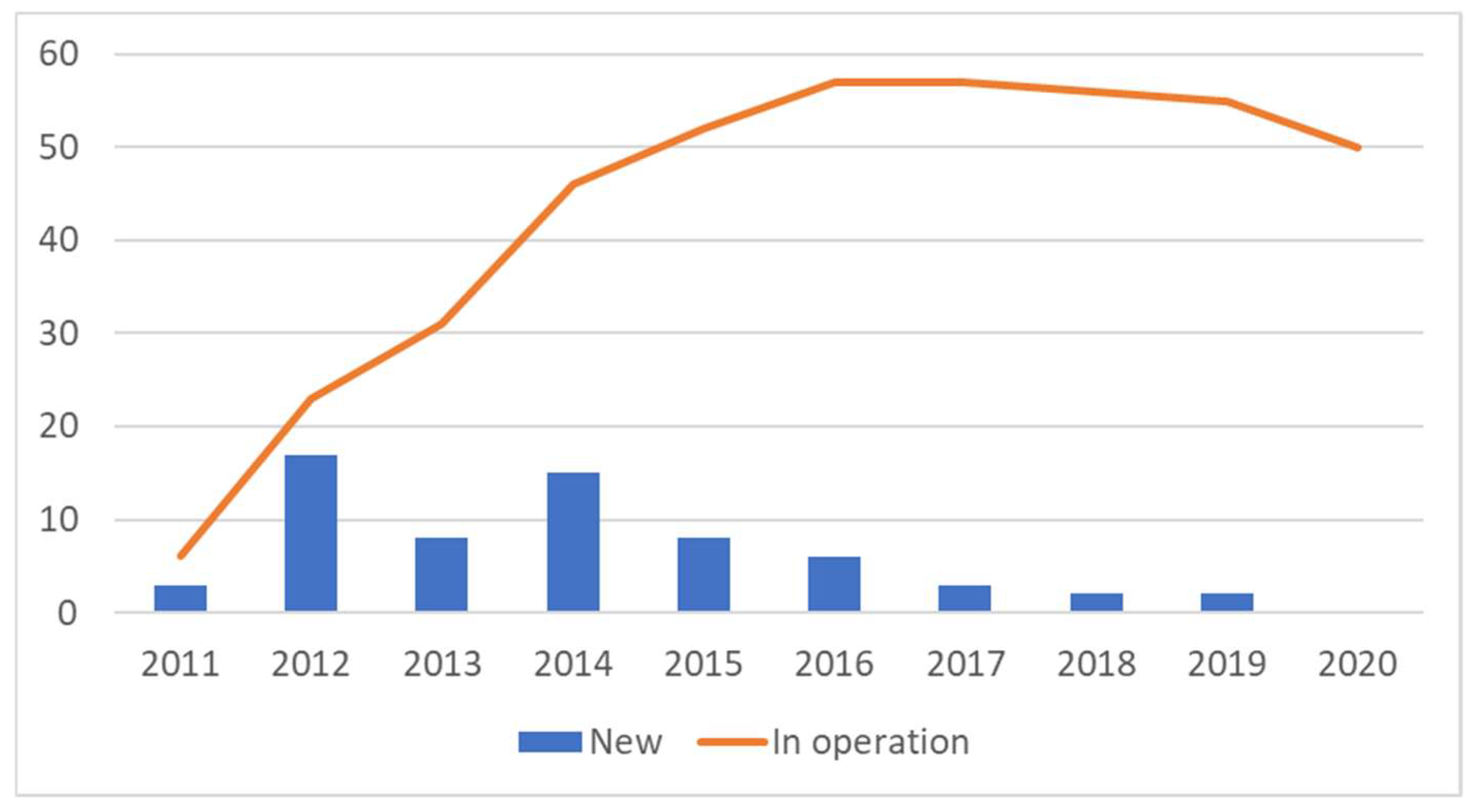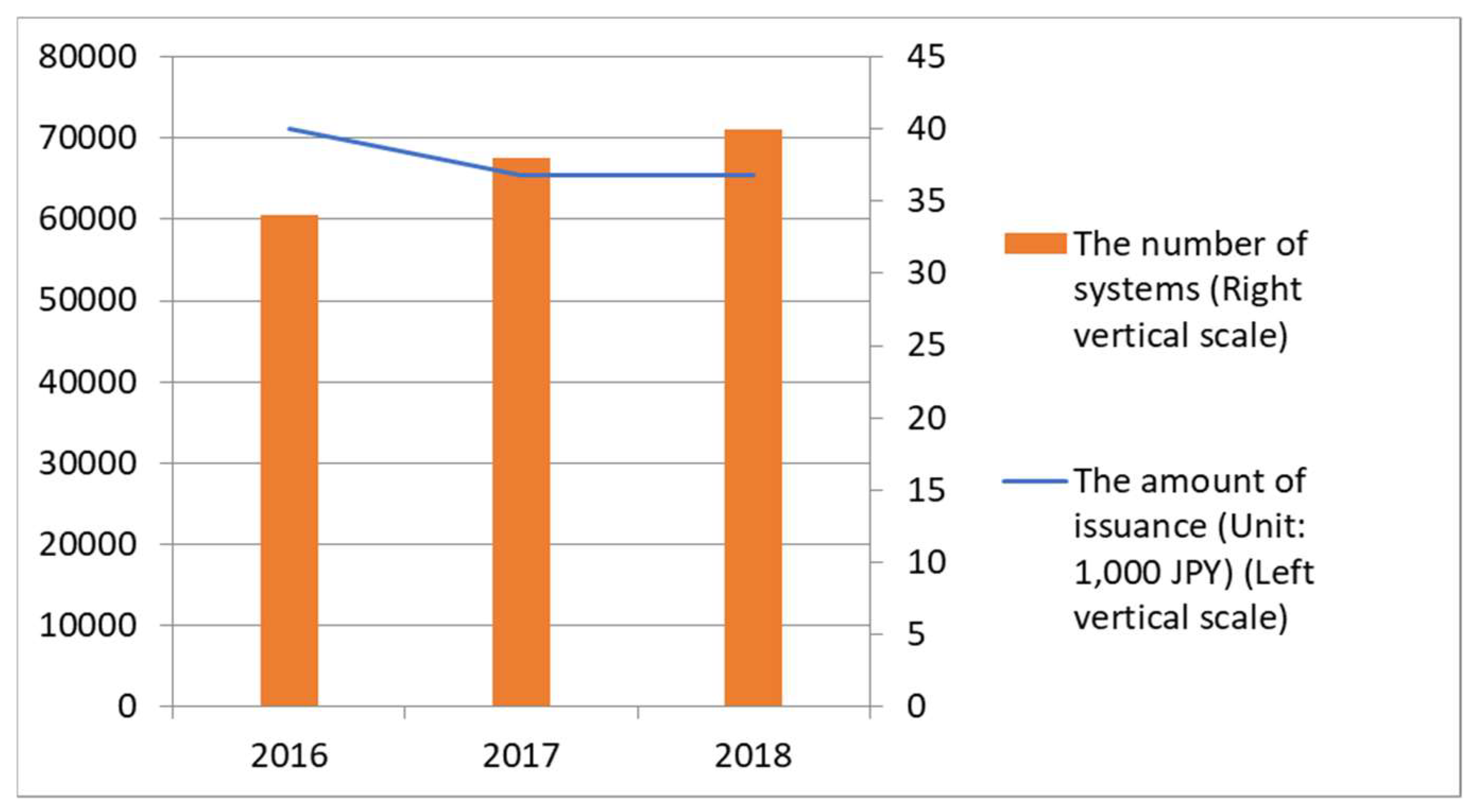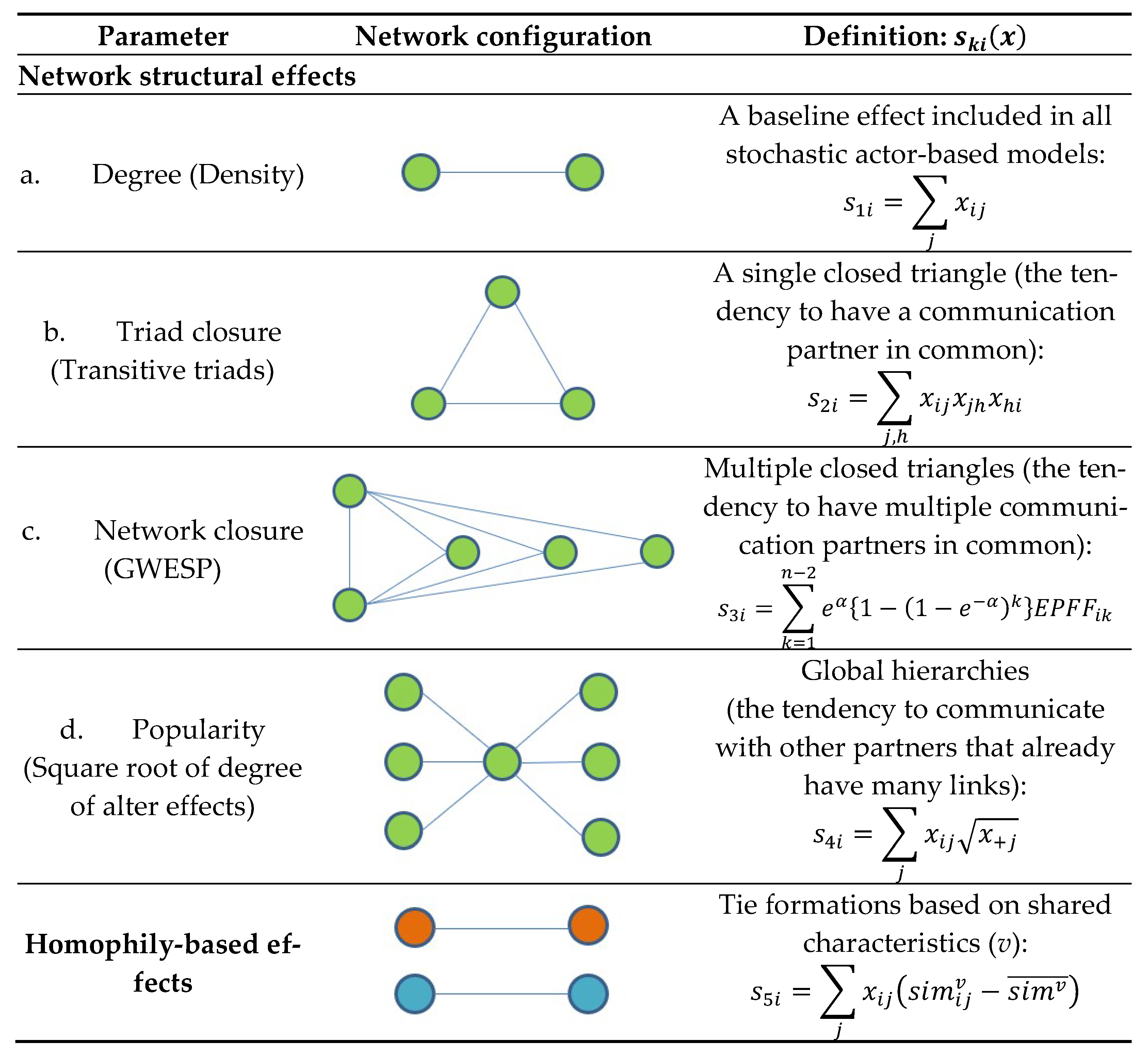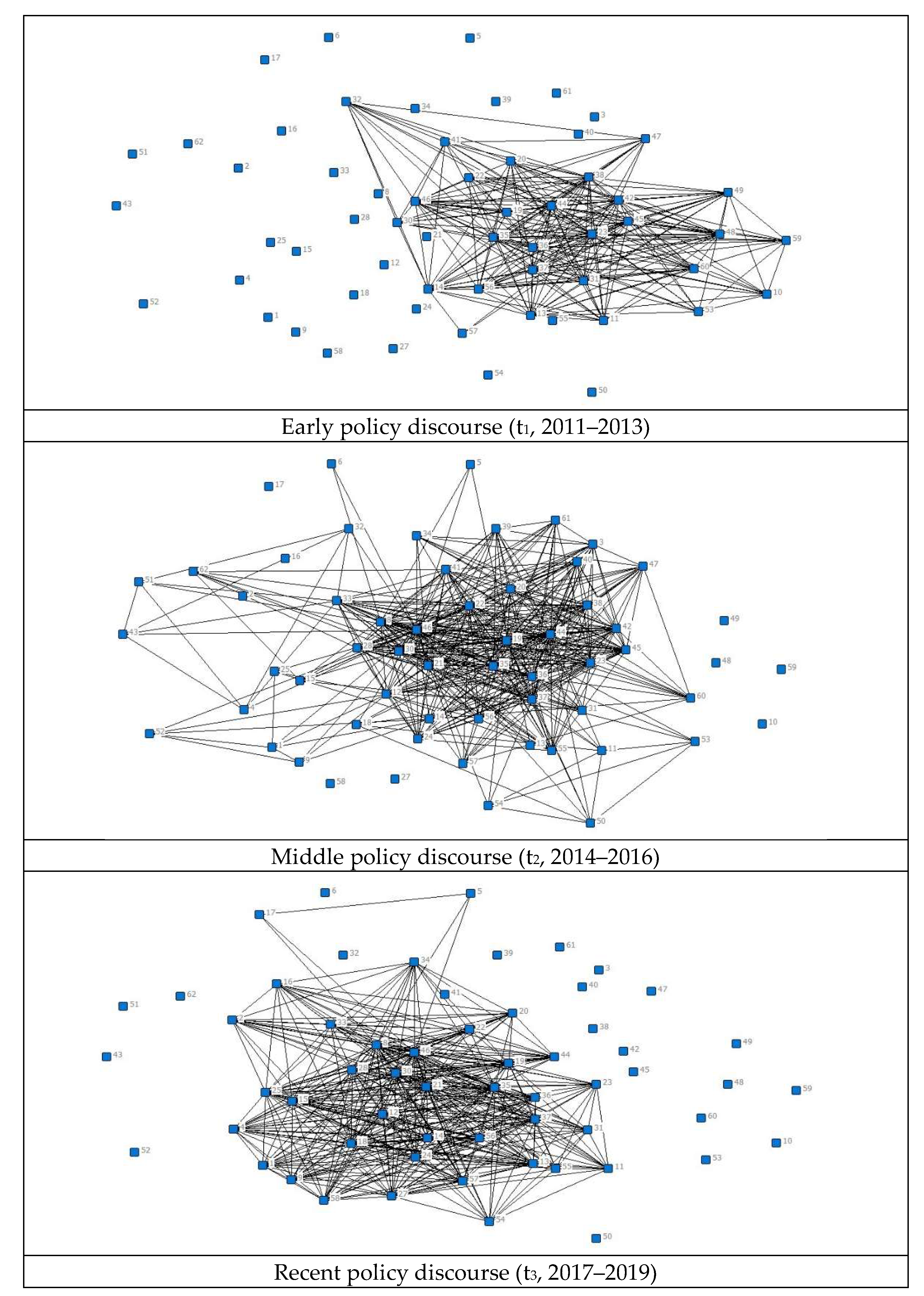Joining Policy Forums Together to Develop Ki-no-Eki, a Community Currency System for Forest Management in Japan: Dynamics of Policy Communication Networks
Abstract
1. Introduction
2. Ki-no-Eki, a Community Currency System for Forest Management
2.1. Reforestation Initiatives, Self-Harvesting Forestry, and Community Currencies
2.2. Ki-no-Eki Based on a Community Currency System
3. Research Methods
3.1. Data on Two-Mode Coparticipation Networks and One-Mode Communication Networks among Ki-no-Eki Organizations
3.2. Stochastic Actor-Oriented Modeling
3.3. Model Specification
4. Results
5. Discussion
6. Conclusions
Author Contributions
Funding
Data Availability Statement
Acknowledgments
Conflicts of Interest
References
- Izumi, R.; Nakazato, H. The current state of Japanese community currency activities based on the 2016 survey. Econ. Bull. Senshu Univ. 2017, 52, 39–53. (In Japanese) [Google Scholar]
- Nakazato, H.; Lim, S. Evolutionary process of social capital formation through community currency organizations: The Japanese case. Volunt. Int. J. Volunt. Nonprofit Organ. 2016, 27, 1171–1194. [Google Scholar] [CrossRef]
- Nakazato, H.; Lim, S. Interplay between social support tie formations and subjective mental health conditions in a community currency system in Japanese disaster-affected communities: The ambivalent effects of social capital. Int. J. Disaster Risk Reduct. 2020, 51, 101809. [Google Scholar] [CrossRef]
- Collom, E. Motivations and differential participation in a community currency system: The dynamics within a local social movement organization. Sociol. Forum 2011, 26, 144–168. [Google Scholar] [CrossRef]
- Seyfang, G.; Longhurst, N. Desperately seeking niches: Grassroots innovations and niche development in the community currency field. Glob. Environ. Chang. 2013, 23, 881–891. [Google Scholar] [CrossRef]
- Nakazato, H.; Lim, S. Community rebuilding processes in a disaster-damaged area through community currency: The pilot project of “Domo” in Kamaishi, Japan. Disaster Prev. Manag. 2017, 26, 79–93. [Google Scholar] [CrossRef]
- Izumi, R.; Nakazato, H. Emerging trends in Japanese community currencies: Based on the “Ki no Eki” Census. Econ. Bull. Senshu Univ. 2021, 55, 153–165. (In Japanese) [Google Scholar]
- Borg, R.; Toikka, A.; Primmer, E. Social capital and governance: A Social network analysis of forest biodiversity collaboration in central Finland. For. Policy Econ. 2015, 50, 90–97. [Google Scholar] [CrossRef]
- Górriz-Mifsud, E.; Secco, L.; Pisani, E. Exploring the interlinkages between governance and social capital: A dynamic model for forestry. For. Policy Econ. 2016, 65, 25–36. [Google Scholar] [CrossRef]
- White, R.M.; Young, J.; Marzano, M.; Leahy, S. Prioritising stakeholder engagement for forest health, across spatial, temporal and governance scales, in an era of austerity. For. Ecol. Manag. 2018, 417, 313–322. [Google Scholar] [CrossRef]
- Valenzuela, R.B.; Yeo-Chang, Y.; Park, M.S.; Chun, J.-N. Local people’s participation in mangrove restoration projects and impacts on social capital and livelihood: A case study in the Philippines. Forests 2020, 11, 580. [Google Scholar] [CrossRef]
- Steffek, J. Discursive legitimation in environmental governance. For. Policy Econ. 2009, 11, 313–318. [Google Scholar] [CrossRef]
- Fischer, M.; Leifeld, P. Policy forum: Why do they exist and what are they used for? Policy Sci. 2015, 48, 363–382. [Google Scholar] [CrossRef]
- Fischer, M.; Angst, M.; Maag, S. Co-participation in the Swiss water forum network. Int. J. Water Resour. Dev. 2019, 35, 446–464. [Google Scholar] [CrossRef]
- Olivier, T.; Berardo, R. Birds of feather fight together: Forum involvement in a weakly institutionalized ecology of policy games. Policy Stud. J. 2022, 50, 176–198. [Google Scholar] [CrossRef]
- Bodin, Ö.; Crona, B.I. The role of social networks in natural resource governance: What relational patterns make a difference? Glob. Environ. Change 2009, 19, 366–374. [Google Scholar] [CrossRef]
- Lim, S. Policy Network Ties in the Dynamic Process of Environmental Conflict Resolution: Uncovering the Evolution of Environmental Governance; Springer: Cham, Switzerland, 2021. [Google Scholar]
- Karunarathne, A.Y.; Lee, G. The geographies of the dynamic evolution of social networks for the flood disaster response and recovery. Appl. Geogr. 2020, 125, 102274. [Google Scholar] [CrossRef]
- Vitiea, K.; Lim, S. Voluntary environmental collaborations and corporate social responsibility in Siem Reap city, Cambodia. Sustain. Account. Manag. Policy J. 2019, 10, 451–475. [Google Scholar] [CrossRef]
- Forestry Agency of Japan. Annual Report on Forest and Forestry in Japan: Fiscal Year 2020; Ministry of Agriculture, Forestry and Fisheries: Tokyo, Japan, 2021. (In Japanese)
- Teramoto, M.; Liang, N.; Takahashi, Y.; Zeng, J.; Saigusa, N.; Ide, R.; Zhao, X. Enhanced understory carbon flux components and robustness of net CO2 exchange after thinning in a larch forest in central Japan. Agric. For. Meteorol. 2019, 274, 106–117. [Google Scholar] [CrossRef]
- Hosoda, K.; Nishizono, T.; Sano, M.; Saito, H.; Iehara, T. Comparison of carbon storage by thinned and unthinned stands in the Japanese cedar, cypress and larch permanent experimental sites. Jpn. Soc. For. Plan. 2012, 45, 2–12. (In Japanese) [Google Scholar] [CrossRef]
- Suzuki, Y.; Murakami, S.; Goto, J.; Nakajima, K.; Kitahara, F.; Tarumi, A.; Nakayama, T.; Tanouchi, H. Analysis of the amount shipped and the shipper’s cost balance for recovered logging residue logs in the woody biomass utilization project of Niyodogawa town, Kochi Prefecture, Japan. J. Jpn. For. Eng. Soc. 2013, 28, 41–50. (In Japanese) [Google Scholar]
- Miyazaki, Y.; Kurita, K. Community currency and sustainable development in hilly and mountainous areas: A case study of forest volunteer activities in Japan. In Monetary Plurality in Local, Regional and Global Economies; Gómez, G.M., Ed.; Routledge: London, UK, 2018. [Google Scholar]
- Sato, N.; Yanaka, S.; Kohroki, K. New Era of Forestry; Nobunkyo: Tokyo, Japan, 2014. (In Japanese) [Google Scholar]
- Specified Nonprofit Corporation Yuudachiyama Shinrin Juku. Ki-no-Eki Project Report 2010; Yuudachiyama Shinrin Juku: Gifu, Japan, 2010. (In Japanese) [Google Scholar]
- Borgatti, S.P.; Everett, M.G. Network analysis of 2-mode data. Soc. Netw. 1997, 19, 243–269. [Google Scholar] [CrossRef]
- Snijders, T.A.B.; van de Bunt, G.G.; Steglich, C.E.G. Introduction to actor-based models for network dynamics. Soc. Netw. 2010, 32, 44–60. [Google Scholar] [CrossRef]
- Lim, S.; Nakazato, H. The emergence of risk communication networks and the development of citizen health-related behaviors during the COVID-19 pandemic: Social selection and contagion processes. Int. J. Environ. Res. Public Health 2020, 17, 4148. [Google Scholar] [CrossRef]
- Ripley, R.M.; Snijders, T.A.B.; Boda, Z.; Voros, A.; Preciado, P. Manual for RSiena; University of Oxford: Oxford, UK; University of Groningen: Groningen, The Netherlands, 2022. [Google Scholar]
- Snijders, T.A.B. Stochastic actor-oriented models for network dynamics. Annu. Rev. Stat. Its Appl. 2017, 4, 343–363. [Google Scholar] [CrossRef]
- Yogev, T.; Grund, T. Network dynamics and market structure: The case of art fairs. Sociol. Focus 2012, 45, 23–40. [Google Scholar] [CrossRef]
- Putnam, R.D. Making Democracy Work: Civic Traditions in Modern Italy; Princeton University Press: Princeton, NJ, USA, 1993. [Google Scholar]
- Ramirez-Sanchez, S.; Pinkerton, E. The impact of resource scarcity on bonding and bridging social capital: The case of fishers’ information-sharing networks in Loreto, BCS, Mexico. Ecol. Soc. 2009, 14, 22. [Google Scholar] [CrossRef]
- Gorriz-Mifsud, E.; Secco, L.; Da Re, R.; Pisani, E.; Bonet, J.A. Structural social capital and local-level forest governance: Do they inter-relate? A mushroom permit case in Catalonia. J. Environ. Manag. 2017, 188, 364–378. [Google Scholar] [CrossRef]
- Alexander, S.M.; Bodin, Ö.; Barnes, M.L. Untangling the drivers of community cohesion in small-scale fisheries. Int. J. Commons 2018, 12, 519–547. [Google Scholar] [CrossRef]
- Leifeld, P.; Schneider, V. Information exchange in policy networks. Am. J. Political Sci. 2012, 56, 731–744. [Google Scholar] [CrossRef]
- Berardo, R. The evolution of self-organizing communication networks in high-risk social-ecological systems. Int. J. Commons 2014, 8, 236–258. [Google Scholar] [CrossRef]
- McPherson, M.; Smith-Lovin, L.; Cook, J.M. Birds of a feather: Homophily in social networks. Annu. Rev. Sociol. 2001, 27, 415–444. [Google Scholar] [CrossRef]
- Borgatti, S.P.; Everett, M.G.; Freeman, L.C. Ucinet for Windows: Software for Social Network Analysis; Analytic Technologies: Harvard, MA, USA, 2002. [Google Scholar]
- Ostrom, E. Governing the Commons: The Evolution of Institutions for Collective; Cambridge University Press: Cambridge, UK, 1990. [Google Scholar]
- Karunarathne, A.Y.; Lee, G. Traditional social capital and socioeconomic networks in response to flood disaster: A case study of rural areas in Sri Lanka. Int. J. Disaster Risk Reduct. 2019, 41, 101279. [Google Scholar] [CrossRef]
- Lim, S.; Nakazato, H. Co-evolving supportive networks and perceived community resilience across disaster-damaged areas after the Great East Japan Earthquake: Selection, influence, or both? J. Contingencies Crisis Manag. 2019, 27, 116–129. [Google Scholar] [CrossRef]





| Observed Period | Number of Ties | Average Degree | Density |
|---|---|---|---|
| Early policy discourse (t1) | 234 | 7.54 | 0.12 |
| Middle policy discourse (t2) | 424 | 13.67 | 0.22 |
| Recent policy discourse (t3) | 405 | 13.06 | 0.21 |
| Observed Period | 0 → 0 (Continued Nonrelationship) | 0 → 1 (Developed Relationship) | 1 → 0 (Terminated Relationship) | 1 → 1 (Maintained Relationship) |
|---|---|---|---|---|
| From t1 to t2 | 1345 | 312 | 122 | 112 |
| From t2 to t3 | 1220 | 247 | 266 | 158 |
| Parameter | Estimate | Standard Error |
|---|---|---|
| Rate | ||
| 1. From t1 to t2 | 22.50 ** | 11.32 |
| 2. From t2 to t3 | 5.06 *** | 1.50 |
| Network structural effects | ||
| 3. Degree (density) | −2.03 ** | 0.86 |
| 4. Triad closure (transitive triads) | 0.11 *** | 0.01 |
| 5. Network closure (GWESP) | 1.89 *** | 0.48 |
| 6. Popularity (square root of degree of alter effects) | −0.63 *** | 0.08 |
| Homophily-based effects | ||
| 7. Region | 0.22 ** | 0.09 |
| 8. Organization age | 0.25 *** | 0.08 |
| 9. Number of shippers | 0.14 | 0.22 |
| 10. Value of community currency issued | −0.29 ** | 0.12 |
Publisher’s Note: MDPI stays neutral with regard to jurisdictional claims in published maps and institutional affiliations. |
© 2022 by the authors. Licensee MDPI, Basel, Switzerland. This article is an open access article distributed under the terms and conditions of the Creative Commons Attribution (CC BY) license (https://creativecommons.org/licenses/by/4.0/).
Share and Cite
Nakazato, H.; Izumi, R.; Lim, S. Joining Policy Forums Together to Develop Ki-no-Eki, a Community Currency System for Forest Management in Japan: Dynamics of Policy Communication Networks. Land 2022, 11, 1811. https://doi.org/10.3390/land11101811
Nakazato H, Izumi R, Lim S. Joining Policy Forums Together to Develop Ki-no-Eki, a Community Currency System for Forest Management in Japan: Dynamics of Policy Communication Networks. Land. 2022; 11(10):1811. https://doi.org/10.3390/land11101811
Chicago/Turabian StyleNakazato, Hiromi, Rui Izumi, and Seunghoo Lim. 2022. "Joining Policy Forums Together to Develop Ki-no-Eki, a Community Currency System for Forest Management in Japan: Dynamics of Policy Communication Networks" Land 11, no. 10: 1811. https://doi.org/10.3390/land11101811
APA StyleNakazato, H., Izumi, R., & Lim, S. (2022). Joining Policy Forums Together to Develop Ki-no-Eki, a Community Currency System for Forest Management in Japan: Dynamics of Policy Communication Networks. Land, 11(10), 1811. https://doi.org/10.3390/land11101811






